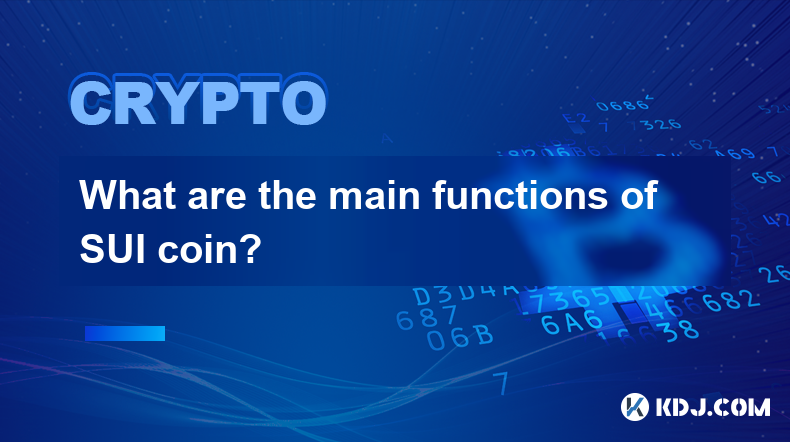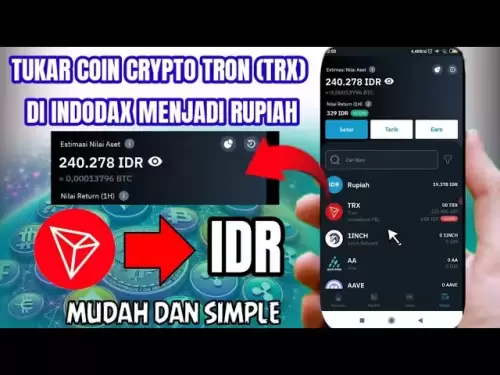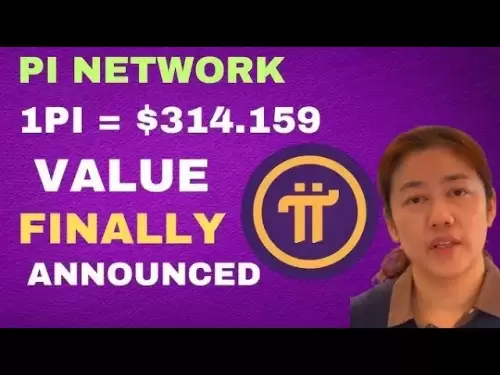-
 Bitcoin
Bitcoin $107,397.3430
-0.20% -
 Ethereum
Ethereum $2,467.5633
1.33% -
 Tether USDt
Tether USDt $1.0002
0.01% -
 XRP
XRP $2.1994
0.71% -
 BNB
BNB $655.8723
1.07% -
 Solana
Solana $157.3780
4.63% -
 USDC
USDC $1.0000
0.02% -
 TRON
TRON $0.2792
1.23% -
 Dogecoin
Dogecoin $0.1645
0.50% -
 Cardano
Cardano $0.5666
1.83% -
 Hyperliquid
Hyperliquid $39.8730
3.91% -
 Bitcoin Cash
Bitcoin Cash $514.7673
5.02% -
 Sui
Sui $2.7969
-0.51% -
 Chainlink
Chainlink $13.2880
0.07% -
 UNUS SED LEO
UNUS SED LEO $9.1148
-0.60% -
 Avalanche
Avalanche $17.9247
0.34% -
 Stellar
Stellar $0.2351
-0.98% -
 Toncoin
Toncoin $2.9456
2.69% -
 Shiba Inu
Shiba Inu $0.0...01144
-0.74% -
 Litecoin
Litecoin $85.9064
-0.62% -
 Hedera
Hedera $0.1495
1.47% -
 Monero
Monero $319.0339
3.82% -
 Polkadot
Polkadot $3.3940
-0.40% -
 Dai
Dai $1.0000
0.01% -
 Ethena USDe
Ethena USDe $1.0003
0.00% -
 Bitget Token
Bitget Token $4.5223
-1.95% -
 Uniswap
Uniswap $7.1384
-0.02% -
 Aave
Aave $272.7534
0.72% -
 Pepe
Pepe $0.0...09836
2.57% -
 Pi
Pi $0.5107
-2.06%
What are the main functions of SUI coin?
SUI powers the Sui blockchain, facilitating transactions, securing the network via staking, and enabling governance. It's used in dApps, NFT interactions, and fuels the ecosystem's growth, making its value intrinsically tied to Sui's success.
Mar 13, 2025 at 12:40 pm

Key Points:
- SUI's primary function is to power the Sui blockchain, a layer-1 network designed for scalability and high throughput.
- It's used for transaction fees, staking to secure the network, and governance participation.
- SUI facilitates the creation and interaction with decentralized applications (dApps) built on the Sui ecosystem.
- Its utility extends to various on-chain activities including NFT minting, trading, and in-game assets.
- The token's value is intrinsically tied to the success and growth of the Sui ecosystem.
What are the main functions of SUI coin?
The SUI coin serves as the native cryptocurrency of the Sui blockchain, a novel layer-1 blockchain built for scalability and high throughput. Its core functions are multifaceted and deeply integrated into the Sui ecosystem's operation and growth. Understanding these functions is key to grasping the coin's overall value proposition.
One of the most fundamental roles of SUI is facilitating transactions on the Sui network. Every interaction, whether it's sending cryptocurrency, deploying a smart contract, or transferring an NFT, incurs a transaction fee payable in SUI. This fee incentivizes network validators to process transactions efficiently and maintain the blockchain's integrity.
Beyond transaction fees, SUI plays a critical role in securing the Sui network through staking. Users can stake their SUI tokens to become validators, contributing to the consensus mechanism that verifies and adds new blocks to the blockchain. In return, stakers receive rewards in SUI, proportionally to their staked amount and the network's overall activity. This incentivizes participation and strengthens the network's security.
Governance is another key area where SUI exerts its influence. SUI holders have the right to participate in on-chain governance proposals, influencing the future direction and development of the Sui ecosystem. This allows the community to directly impact the platform's evolution, fostering a decentralized and community-driven environment.
The functionality of SUI extends beyond the core operations of the blockchain. It is integral to the burgeoning ecosystem of decentralized applications (dApps) built on Sui. Many dApps utilize SUI for in-app payments, rewards, and governance mechanisms. This interconnectedness expands the utility of SUI and creates a more vibrant and interconnected ecosystem.
Furthermore, SUI plays a crucial role in the burgeoning NFT landscape within the Sui ecosystem. Users can mint, trade, and interact with NFTs using SUI. This creates a marketplace for digital assets and fosters innovation in digital ownership and asset management. The use of SUI in this context directly contributes to its value and utility.
The Sui blockchain's design prioritizes speed and efficiency. This translates directly to SUI's utility, as fast and inexpensive transactions are crucial for the widespread adoption of any cryptocurrency. The improved speed and efficiency compared to other blockchains are directly tied to the value proposition of the SUI coin. The faster the network, the more transactions can be processed, further solidifying SUI’s utility.
Beyond the immediate functions, the value of SUI is closely linked to the overall success and growth of the Sui ecosystem. As more dApps are built, more users join the network, and more transactions are processed, the demand for SUI is likely to increase, potentially driving up its price. The network effect is a powerful driver of cryptocurrency value, and SUI is directly exposed to this effect.
The future of SUI is intrinsically linked to the innovation and adoption of the Sui blockchain. Continuous development and the addition of new features will directly impact the utility and value of the SUI token. This makes SUI a dynamic asset whose value fluctuates based on the evolving landscape of the blockchain. Ongoing development is essential for the long-term viability of the SUI token.
How is SUI different from other Layer-1 cryptocurrencies?
Sui distinguishes itself through its focus on scalability and speed, leveraging a novel object-based programming model. Unlike many other Layer-1 blockchains, Sui aims to offer significantly faster transaction speeds and lower costs, making it more suitable for a wider range of applications.
What are the risks associated with investing in SUI?
Investing in SUI, like any cryptocurrency, carries inherent risks. Market volatility, regulatory uncertainty, and technological vulnerabilities are all potential factors that could negatively impact its value. Furthermore, the relatively new nature of the Sui ecosystem introduces additional risks.
How can I acquire SUI coins?
SUI coins can be acquired through various centralized and decentralized exchanges (CEXs and DEXs). It's crucial to research and choose reputable platforms before engaging in any transactions.
What are the future prospects for SUI?
The future prospects of SUI are highly dependent on the success and adoption of the Sui blockchain. Continued development, community growth, and the emergence of compelling dApps will be key factors determining its long-term viability and potential.
What is the role of SUI in the Sui ecosystem?
SUI serves as the lifeblood of the Sui ecosystem. It fuels transactions, secures the network, and empowers community governance. Its utility is intertwined with every aspect of the Sui blockchain's functionality.
Disclaimer:info@kdj.com
The information provided is not trading advice. kdj.com does not assume any responsibility for any investments made based on the information provided in this article. Cryptocurrencies are highly volatile and it is highly recommended that you invest with caution after thorough research!
If you believe that the content used on this website infringes your copyright, please contact us immediately (info@kdj.com) and we will delete it promptly.
- Unlock Crypto Riches: Mining Platforms & Starter Bonuses - Your Gateway to Digital Gold!
- 2025-06-30 22:30:11
- Dogecoin, Cloud Mining, and Risk Alerts: Navigating the Meme Minefield
- 2025-06-30 22:30:11
- Ric Edelman's Bold Crypto Allocation: A Financial Advisor's Perspective
- 2025-06-30 22:50:12
- Bitcoin Layer-2 Presale Heats Up: Is HYPER the Next Big Thing?
- 2025-06-30 22:50:12
- Bitcoin's Bull Run: Network Activity Tells a Different Story
- 2025-06-30 22:55:12
- SpacePay, Altcoins & Investing in 2025: What's the Buzz?
- 2025-06-30 23:10:12
Related knowledge

How to customize USDT TRC20 mining fees? Flexible adjustment tutorial
Jun 13,2025 at 01:42am
Understanding USDT TRC20 Mining FeesMining fees on the TRON (TRC20) network are essential for processing transactions. Unlike Bitcoin or Ethereum, where miners directly validate transactions, TRON uses a delegated proof-of-stake (DPoS) mechanism. However, users still need to pay bandwidth and energy fees, which are collectively referred to as 'mining fe...

USDT TRC20 transaction is stuck? Solution summary
Jun 14,2025 at 11:15pm
Understanding USDT TRC20 TransactionsWhen users mention that a USDT TRC20 transaction is stuck, they typically refer to a situation where the transfer of Tether (USDT) on the TRON blockchain has not been confirmed for an extended period. This issue may arise due to various reasons such as network congestion, insufficient transaction fees, or wallet-rela...

How to cancel USDT TRC20 unconfirmed transactions? Operation guide
Jun 13,2025 at 11:01pm
Understanding USDT TRC20 Unconfirmed TransactionsWhen dealing with USDT TRC20 transactions, it’s crucial to understand what an unconfirmed transaction means. An unconfirmed transaction is one that has been broadcasted to the blockchain network but hasn’t yet been included in a block. This typically occurs due to low transaction fees or network congestio...

How to check USDT TRC20 balance? Introduction to multiple query methods
Jun 21,2025 at 02:42am
Understanding USDT TRC20 and Its ImportanceUSDT (Tether) is one of the most widely used stablecoins in the cryptocurrency market. It exists on multiple blockchain networks, including TRC20, which operates on the Tron (TRX) network. Checking your USDT TRC20 balance accurately is crucial for users who hold or transact with this asset. Whether you're sendi...

What to do if USDT TRC20 transfers are congested? Speed up trading skills
Jun 13,2025 at 09:56am
Understanding USDT TRC20 Transfer CongestionWhen transferring USDT TRC20, users may occasionally experience delays or congestion. This typically occurs due to network overload on the TRON blockchain, which hosts the TRC20 version of Tether. Unlike the ERC20 variant (which runs on Ethereum), TRC20 transactions are generally faster and cheaper, but during...

The relationship between USDT TRC20 and TRON chain: technical background analysis
Jun 12,2025 at 01:28pm
What is USDT TRC20?USDT TRC20 refers to the Tether (USDT) token issued on the TRON blockchain using the TRC-20 standard. Unlike the more commonly known ERC-20 version of USDT (which runs on Ethereum), the TRC-20 variant leverages the TRON network's infrastructure for faster and cheaper transactions. The emergence of this version came as part of Tether’s...

How to customize USDT TRC20 mining fees? Flexible adjustment tutorial
Jun 13,2025 at 01:42am
Understanding USDT TRC20 Mining FeesMining fees on the TRON (TRC20) network are essential for processing transactions. Unlike Bitcoin or Ethereum, where miners directly validate transactions, TRON uses a delegated proof-of-stake (DPoS) mechanism. However, users still need to pay bandwidth and energy fees, which are collectively referred to as 'mining fe...

USDT TRC20 transaction is stuck? Solution summary
Jun 14,2025 at 11:15pm
Understanding USDT TRC20 TransactionsWhen users mention that a USDT TRC20 transaction is stuck, they typically refer to a situation where the transfer of Tether (USDT) on the TRON blockchain has not been confirmed for an extended period. This issue may arise due to various reasons such as network congestion, insufficient transaction fees, or wallet-rela...

How to cancel USDT TRC20 unconfirmed transactions? Operation guide
Jun 13,2025 at 11:01pm
Understanding USDT TRC20 Unconfirmed TransactionsWhen dealing with USDT TRC20 transactions, it’s crucial to understand what an unconfirmed transaction means. An unconfirmed transaction is one that has been broadcasted to the blockchain network but hasn’t yet been included in a block. This typically occurs due to low transaction fees or network congestio...

How to check USDT TRC20 balance? Introduction to multiple query methods
Jun 21,2025 at 02:42am
Understanding USDT TRC20 and Its ImportanceUSDT (Tether) is one of the most widely used stablecoins in the cryptocurrency market. It exists on multiple blockchain networks, including TRC20, which operates on the Tron (TRX) network. Checking your USDT TRC20 balance accurately is crucial for users who hold or transact with this asset. Whether you're sendi...

What to do if USDT TRC20 transfers are congested? Speed up trading skills
Jun 13,2025 at 09:56am
Understanding USDT TRC20 Transfer CongestionWhen transferring USDT TRC20, users may occasionally experience delays or congestion. This typically occurs due to network overload on the TRON blockchain, which hosts the TRC20 version of Tether. Unlike the ERC20 variant (which runs on Ethereum), TRC20 transactions are generally faster and cheaper, but during...

The relationship between USDT TRC20 and TRON chain: technical background analysis
Jun 12,2025 at 01:28pm
What is USDT TRC20?USDT TRC20 refers to the Tether (USDT) token issued on the TRON blockchain using the TRC-20 standard. Unlike the more commonly known ERC-20 version of USDT (which runs on Ethereum), the TRC-20 variant leverages the TRON network's infrastructure for faster and cheaper transactions. The emergence of this version came as part of Tether’s...
See all articles

























































































